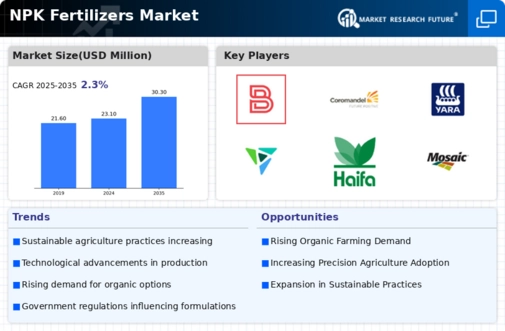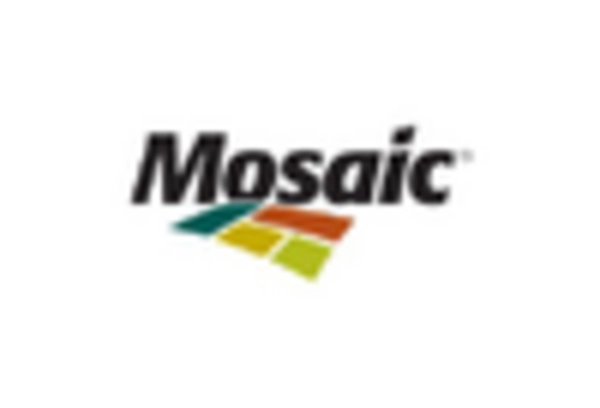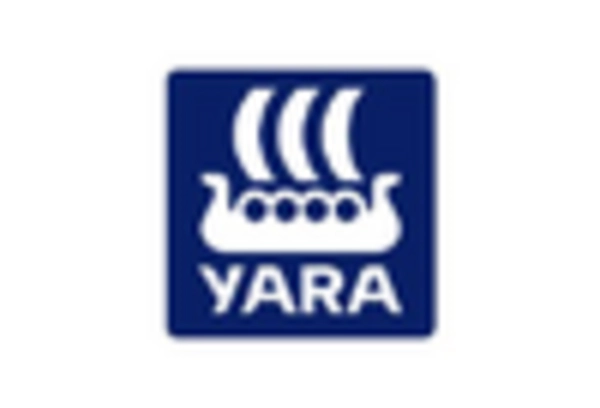Market Analysis
NPK Fertilizers (Global, 2024)
Introduction
The NPK fertilizers market is poised for significant evolution as agricultural practices increasingly prioritize efficiency and sustainability. NPK fertilizers, which provide essential nutrients—nitrogen (N), phosphorus (P), and potassium (K)—are critical in enhancing crop yield and quality. As global food demand escalates, driven by population growth and changing dietary preferences, the agricultural sector is under pressure to adopt innovative fertilization techniques that maximize productivity while minimizing environmental impact. This report delves into the dynamics of the NPK fertilizers market, exploring key trends, technological advancements, and regulatory frameworks that shape the landscape. Additionally, it examines the competitive environment, highlighting the strategies employed by leading manufacturers to capture market share and respond to the evolving needs of farmers worldwide. Understanding these factors is essential for stakeholders aiming to navigate the complexities of the NPK fertilizers market and capitalize on emerging opportunities.
PESTLE Analysis
- Political
- In 2024, government policies regarding agricultural practices and fertilizer usage are increasingly influenced by sustainability initiatives. For instance, the European Union has set a target to reduce nitrogen fertilizer usage by 20% by 2030, which directly impacts the NPK fertilizers market. Additionally, the U.S. government has allocated approximately $1.5 billion in subsidies for sustainable farming practices, which includes the promotion of efficient fertilizer use to minimize environmental impact.
- Economic
- The global agricultural sector is projected to reach a value of $3.5 trillion in 2024, with fertilizers playing a crucial role in crop yield enhancement. The NPK fertilizers market is expected to benefit from this growth, particularly in developing regions where agricultural productivity is being prioritized. In India, for example, the government has announced a budget of ₹1.2 trillion (approximately $14.5 billion) for agricultural development, which includes investments in fertilizer subsidies and infrastructure.
- Social
- Consumer awareness regarding food quality and safety is on the rise, with 65% of consumers in a recent survey indicating a preference for sustainably produced food. This shift in consumer behavior is pushing farmers to adopt more environmentally friendly practices, including the use of NPK fertilizers that are optimized for lower environmental impact. Furthermore, educational programs on sustainable agriculture are being implemented in various countries, reaching over 2 million farmers in 2024.
- Technological
- Advancements in precision agriculture technology are transforming the NPK fertilizers market. In 2024, it is estimated that 30% of farms globally will utilize precision farming techniques, which include soil sensors and data analytics to optimize fertilizer application. This technology not only enhances crop yields but also reduces fertilizer waste, with studies showing that precision application can decrease fertilizer use by up to 15% without compromising yield.
- Legal
- Regulatory frameworks surrounding fertilizer use are becoming more stringent. In 2024, the U.S. Environmental Protection Agency (EPA) has implemented new regulations that require all NPK fertilizers to meet specific nutrient efficiency standards, affecting approximately 40% of the market. Compliance with these regulations is essential for manufacturers, as non-compliance could result in fines exceeding $500,000 per violation.
- Environmental
- The environmental impact of fertilizers is under increasing scrutiny, with the global nitrogen runoff contributing to dead zones in oceans estimated at 245,000 square kilometers in 2024. This has led to a push for more sustainable fertilizer practices, with initiatives aimed at reducing nitrogen leaching by 30% in agricultural runoff. Additionally, the adoption of eco-friendly NPK formulations is on the rise, with a projected increase of 25% in the market share of organic fertilizers by 2025.
Porter's Five Forces
- Threat of New Entrants
- Medium - The NPK fertilizers market has moderate barriers to entry due to the need for significant capital investment in production facilities and technology. Additionally, established brands have strong customer loyalty and distribution networks, which can deter new entrants. However, the growing demand for fertilizers presents opportunities for new players, especially those focusing on sustainable and organic options.
- Bargaining Power of Suppliers
- Low - The bargaining power of suppliers in the NPK fertilizers market is relatively low. There are numerous suppliers of raw materials such as nitrogen, phosphorus, and potassium, which leads to a competitive supply environment. This abundance allows manufacturers to switch suppliers easily, reducing the suppliers' leverage over pricing and terms.
- Bargaining Power of Buyers
- High - Buyers in the NPK fertilizers market, including farmers and agricultural businesses, have high bargaining power due to the availability of various fertilizer options and the ability to switch between brands. Price sensitivity is significant, especially in competitive agricultural markets, which forces manufacturers to offer competitive pricing and value-added services to retain customers.
- Threat of Substitutes
- Medium - The threat of substitutes for NPK fertilizers is moderate. While there are alternative fertilizers and organic options available, many farmers still rely on NPK fertilizers for their effectiveness and efficiency in boosting crop yields. However, the increasing trend towards organic farming and sustainable practices may encourage some farmers to consider substitutes, impacting the market.
- Competitive Rivalry
- High - The competitive rivalry in the NPK fertilizers market is high, with numerous players vying for market share. Established companies compete on price, product quality, and innovation, while new entrants are trying to carve out niches with unique offerings. This intense competition can lead to price wars and increased marketing expenditures, impacting overall profitability in the sector.
SWOT Analysis
Strengths
- High nutrient content leading to improved crop yields.
- Established market presence with strong brand loyalty.
- Diverse product formulations catering to various crops and soil types.
Weaknesses
- Dependency on raw material prices which can be volatile.
- Environmental concerns related to chemical fertilizers.
- Limited awareness among smallholder farmers about optimal usage.
Opportunities
- Growing demand for organic and sustainable farming practices.
- Technological advancements in fertilizer production and application.
- Expansion into emerging markets with increasing agricultural activities.
Threats
- Regulatory changes aimed at reducing chemical fertilizer usage.
- Competition from alternative fertilizers and organic options.
- Climate change impacting agricultural productivity and fertilizer effectiveness.
Summary
The NPK fertilizers market in 2024 is characterized by strong product offerings and established brand loyalty, but faces challenges such as raw material price volatility and environmental concerns. Opportunities for growth lie in the increasing demand for sustainable practices and technological advancements, while threats include regulatory changes and competition from organic alternatives. Companies must leverage their strengths and address weaknesses to capitalize on emerging opportunities and mitigate potential threats.

















Leave a Comment